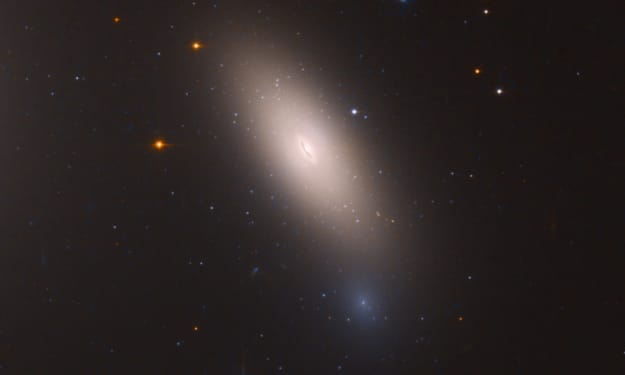GIANT EXOPLANET HELPS EXPLAIN SOLAR SYSTEM FORMATION
A giant exoplanet has been discovered orbiting a low-mass star. Find out why this finding challenges our understanding of planet formation and helps scientists decipher the origins of solar systems, including our own.

One thing that keeps stargazing interesting is the way the constellations move across the sky throughout the year. If I’m at my cottage over the Victoria Day long weekend, one of the most prominent attractions in the clear dark sky is a very bright star over the southern horizon called Spica.
Spica is in the constellation Virgo, and just below and to the right of that bright, blue star is a quadrilateral-shaped constellation called Corvus, the crow.
Corvus is in the news this week because a team of scientists have discovered an unusual star-and-planet combination in that part of the sky. It involves a low-mass star called TOI-4860.
SEARCHING FOR PLANETS AROUND OTHER STARS
Astronomers weren’t even sure there were planets around other stars until 1995. That’s when Swiss astronomers Michael Mayor and Didier Queloz detected a planet orbiting a star in the constellation Pegasus.
NASA launched the Kepler space telescope in 2009, and it succeeded in detecting more than 2,600 planets outside our solar system. These are called exoplanets, and we now know that most stars have planets, many of which are rocky and earth-like.
Doctor Amaury Triaud is a professor of exoplanetology in the University of Birmingham’s School of Physics and Astronomy. He’s on a quest to gather factual evidence about the processes behind how planets form and evolve.
ATACAMA DESERT HOSTS WORLD’S MOST POWERFUL TELESCOPES
Professor Triaud spends a lot of time in Chile’s Atacama desert. That’s the location of six of the world’s most powerful telescopes, including the European Southern Observatory’s Paranal facility.
Professor Triaud led a study at Paranal’s SPECULOOS South Observatory that appears in the Monthly Notices of the Royal Astronomical Society this week. The team discovered a peculiar, giant exoplanet orbiting TOI-4860.
Astronomers don’t expect stars with as little mass as TOI-4860 to have Jupiter-sized gas giant planets in their orbits. The other oddity the researchers found is that this newly discovered planet has unusually high levels of heavy elements.
PLANET DETECTED BY NASA’S TESS MISSION
The first hint of this giant exoplanet came from NASA’s Transiting Exoplanet Survey Satellite (TESS). Launched in 2018, TESS is an all-sky survey mission that identifies planets around bright stars for follow-up study by ground-based observatories.
TESS detected a drop in the low-mass star’s brightness, but couldn’t confirm that a transiting planet caused the dimming. The SPECULOOS team measured the planetary signal in multiple wavelengths and confirmed there was a planet there.
They could tell the object was a planet because it wasn’t emitting any light. Working with Japan’s Subaru Telescope in Hawaii, scientists managed to work out the planet’s mass. When they realized the object was a giant exoplanet, they knew they were challenging conventional wisdom.
“PLANETS LIKE JUPITER WERE WIDELY EXPECTED NOT TO FORM”
“Under the canonical planet formation model, the less mass a star has, the less massive is the disc of material around that star,” explained team member and PhD student George Dransfield. “Since planets are created from that disc, high-mass planets like Jupiter, were widely expected not to form.”
The team were sceptical about this rule of thumb and wanted to test it. So, they started investigating low-mass stars like TOI-4860.
The results from TOI-4860 provide the team’s first example of a low-mass star with a high-mass planet. It’s also the lowest mass star with a giant exoplanet in its orbit anyone has observed to date.
“VITAL TO OUR UNDERSTANDING OF PLANET FORMATION”
Professor Triaud gives most of the credit for the discovery to his team of students. “I am ever thankful to the bright PhD students of our team for proposing to observe systems like TOI-4860. Their work has really paid off since planets like TOI-4860 are vital to deepening our understanding of planet formation.”
Having made the discovery, the researchers began work on why and how a giant exoplanet could form around TOI-4860. They’ve come up with a working hypothesis.
“A hint of what might have happened is hidden in the planetary properties, which appear particularly enriched in heavy elements,” Professor Triaud explained. “We have detected something similar in the host star too, so it is likely that an abundance of heavy elements catalyzed the planet formation process.”
“ABUNDANCE OF HEAVY ELEMENTS CATALYZED PLANET FORMATION”
In our solar system, all the gas giant planets are in outer orbits far beyond Mars. So, we tend to think of these types of planets as very cold.
However, that doesn’t have to be the case. Astronomers have discovered giant exoplanets that orbit very close to their suns, which they term either Hot or Warm Jupiters based on their temperatures.
The newly discovered gas giant around TOI-4860 is extremely close to its sun, completing its entire orbit in only 1.52 days. Even so, since the star has a relatively low temperature and low mass, astronomers consider it a Warm Jupiter.
“BRILLIANT OPPORTUNITY TO STUDY PROPERTIES OF A WARM JUPITER”
Mathilde Timmermans is a PhD student at the University of Liege in Belgium and another SPECULOOS team member. As she explains, “Thanks to its very short orbital period, and to the properties of its host star, the discovery of TOI-4860 b provides a brilliant opportunity to study the atmospheric properties of a warm Jupiter and learn more about how gas giants are formed.”
Discoveries like these continue to remind us that we’re still unveiling the new story of our universe and our place in it. It’s important that humanity continues to challenge preconceptions such as limitations on where giant exoplanets can form and the various star categories that might host them.
AND ANOTHER THING…
As planets beyond our solar system reveal themselves, we gain a broader and deeper understanding of the cosmos. The existence of other planets and solar systems reminds us that our world is part of a vast celestial community.
The bizarre and harsh conditions on the newly discovered giant exoplanet with its heavy elements also prompts us to consider our precious, life-sustaining conditions here on Earth. While a Warm Jupiter is fascinating, we need to put a stop to the artificial warming we’re enduring here at home.
The team will be shifting their work to Chile’s Very Large Telescope (VLT), which is also in the Atacama. They plan to use their time with he VLT studing a few other target planets with comparable characteristics.
We always have more to learn if we dare to know.
Learn more:
New exoplanet discovery builds better understanding of planet formation
An M dwarf accompanied by a close-in giant orbiter with SPECULOOS
Mars Exploration News: A Month of Discovery
About the Creator
David Morton Rintoul
I'm a freelance writer and commercial blogger, offering stories for those who find meaning in stories about our Universe, Nature and Humanity. We always have more to learn if we Dare to Know.






Comments
There are no comments for this story
Be the first to respond and start the conversation.